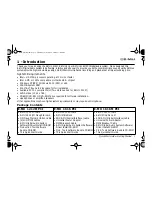
ME910C1 mPCIe HW Design Guide
1VV0301642 Rev. 2
Page 30 of 56
2022-01-14
Not Subject to NDA
Note: This LED_WWAN_N signal is not active by default.
Refer to AT#SLED description in the AT Command User Guide
[2][6].
Hardware Interfaces
Following table below summarize all hardware interfaces available.
Interface
ME910X1-mPCIe
USB
USB2.0
UART
HS-UART (up to 4 Mbps)
Audio I/F
I2S/PCM
USIM
Dual voltage (1.8V/2.85V)
Antenna ports
2 for Cellular, 1 for GNSS
Table 17 Hardware Interfaces
6.6.1.
USB Port
The ME910X1-mPCIe module includes a Universal Serial Bus (USB) transceiver, which
operates at USB high-speed (480 Mbits/sec). It can also operate with USB full-speed
hosts (12 Mbits/sec).
It is compliant with the USB 2.0 specification and can be used for control and data
transfers as well as for diagnostic monitoring and firmware update.
The USB port is typically the main interface between the ME910X1-mPCIe module and
OEM hardware.
Table Below lists the USB interface signals:
Signal
Pin No
Usage
USB_D-
36
Minus (-) line of the differential, bi-directional USB signal to/from the peripheral device
USB_D+
38
Plus (+) line of the differential, bi-directional USB signal to/from the peripheral device
Table 18 USB Interface
Note: The USB_D+ and USB_D- signals have a clock rate of 480 MHz.
Signal traces must be routed carefully. Minimize trace lengths,
number of vias, and capacitive loading. The impedance value should
be as close to 90 Ohms differential as possible and well isolated from
other digital signals.
















































